| WALKING ON THE MOON

Journey to The Lost World of Mount Roraima
| Ever since Walter
Raleigh described a mountain of crystal on his deluded
expedition up the Orinoco to find Lake Manoa and El Dorado,
the sandstone plateaux of the Guayana Shield have attracted
curiosity and conjecture, botanists and explorers, missionaries
and fortune hunters. |
 Roraima
is the highest of the extraordinary mesa mountains that puncture
the plains of the ancient shield. Its flanks rise sheer above
the surrounding forests and savannahs, reaching 2,800 meters.
Its surface spans some 40 square kilometres, over six times
the size of Gibraltar. In the nineteenth century, reports
given at the Royal Geographic Society from this far-flung
corner of the Empire convinced many members that life on the
summit of Roraima, isolated from the world, could have been
suspended in its evolutionary development. Roraima
is the highest of the extraordinary mesa mountains that puncture
the plains of the ancient shield. Its flanks rise sheer above
the surrounding forests and savannahs, reaching 2,800 meters.
Its surface spans some 40 square kilometres, over six times
the size of Gibraltar. In the nineteenth century, reports
given at the Royal Geographic Society from this far-flung
corner of the Empire convinced many members that life on the
summit of Roraima, isolated from the world, could have been
suspended in its evolutionary development.
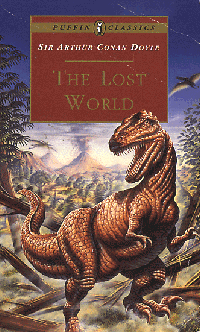 Speculation, at the height
of the great evolutionary debates in England, reached fever
pitch. In April 1877, only six years after the publication
of Descent of Man, an editorial in The Spectator pleaded "Will
no one explore Roraima and bring us back the tidings which
it has been waiting these thousands of years to give us?"
Various frustrated expeditions answered the call, but it took
until 1884 for the incongruous-sounding pair of Everard Im
Thurn and Harry Perkins, sponsored by the Royal Geographical
Society, the Royal Society and the British Association, to
bring back finally descriptions of its mysterious summit.
Im Thurn's account of his Jack and the Beanstalk adventure,
brimming with breathless conjunctions, is pure Boy's Own: Speculation, at the height
of the great evolutionary debates in England, reached fever
pitch. In April 1877, only six years after the publication
of Descent of Man, an editorial in The Spectator pleaded "Will
no one explore Roraima and bring us back the tidings which
it has been waiting these thousands of years to give us?"
Various frustrated expeditions answered the call, but it took
until 1884 for the incongruous-sounding pair of Everard Im
Thurn and Harry Perkins, sponsored by the Royal Geographical
Society, the Royal Society and the British Association, to
bring back finally descriptions of its mysterious summit.
Im Thurn's account of his Jack and the Beanstalk adventure,
brimming with breathless conjunctions, is pure Boy's Own:
"Up
this part of the slope we made our way with comparative ease
till we reached a point where one step more would bring our
eyes on a level with the top - and we should see what had
never been seen since the world began [...] should see that
of which all the few, white men or red, whose eyes have ever
rested on the mountain had declared would never be seen while
the world lasts - should learn what is on top of Roraima."
Sir
Arthur Conan Doyle drew on these vivid accounts to pen his
classic, if somewhat far-fetched The Lost World, published
in 1912, wherein the intrepid Professor Challenger encounters
pterodactyls and prehistoric cavemen running amok atop the
mountain. Two Hollywood films later, scientists are still
finding new species across the reach of these islands in time.
REVERENTIAL LOCALS AND PRESUMPTIOUS VISITORS
The
Pemon Indians that live in Roraima's shadow regard the 'tepuy'
('mountain' in their tongue) as the Source of All Waters,
home of the Goddess Kuín, grandmother of all Men. Its name
means 'large blue-green mountain.' The Pemon cherish and revere
Roraima. Richard Schomburgk, in his early Victorian expeditions
with his brother, noted "All their festive songs have
Roraima for subject matter, and when we told them of the beauties
of Pirara [...] their comment was and remained: 'It cannot
be nice in that place: there is no Roraima there.' "
In 1915, Mrs Cecil Clementi, wife of a diplomat posted in
Guiana, became the first woman to ascend the mountain. She,
like all visitors before or since, was spellbound. "We
felt smitten with awe and fear. We seemed so minute and presumptuous
to venture unbidden into the presence of these towering monsters
in a land that knew us not... Well may the Indians feel that
the place is holy ground!"
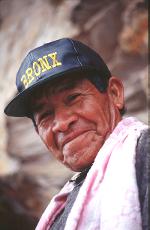 Even
though Julio, my sexagenarian Pemon guide, has climbed Roraima
more times than he has grandchildren (no less than twenty),
he still gets emotional about the mountain. Even
though Julio, my sexagenarian Pemon guide, has climbed Roraima
more times than he has grandchildren (no less than twenty),
he still gets emotional about the mountain.
"Look,"
he'd say, pointing to the mountain with no more than his protruding
lips, then pause, "beautiful."
Julio first climbed
Roraima in 1952, "when I was a youngster still,"
he chuckles. He guided the first expedition up the mountain's
twin, Kukenan. He spent three weeks looking for a way up.
Was
he ever scared?" I ask him.
"Maybe
the first time," he answers, "but then I would whisper
some taren (magical invocations), and always brought my machete
with me."
Julio's
present machete looks like it dates from another British expedition,
this time in 1964. On its blade, the words "Stainless
Steel" are still legible, but below them, only the upper
letters of "Birmingham" have survived decades of
diligent sharpening.
SERMONS IN STONE
We
spent our first night camped by the River Kukenan, close to
the villages where was villagers welcomed and fed Im Thurn.
The settlements have long since been abandoned, although one
can still make out the flattened earth circles where thatched
huts once stood. From this point, Roraima and Kukenan loomed
over the evening sky to the east and north-east, their sides
etched with white-line waterfalls. 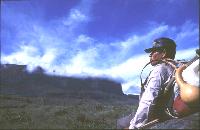 Roraima's
south-western flank runs at a near right angle to Kukenan's
wall, forming an amphitheatre of rock into which unsuspecting
clouds drifted and dissipated. Only rarely do these "sermons
in stone" deign to reveal themselves fully. The rest
of the time they play hide and seek, skulking behind banks
of vapour. From here, Schomburgk "gazed in dumb amazement
at the mass of mountain with its sparkling bands of water
spreading itself out before me, until it became suddenly enveloped
in an envious veil of mist." Im Thurn's Indians never
tired of telling him that Roraima cloaked itself "whenever
approached by white men." With up to four metres of rainfall
a year in the area, the fabulous mountain lies, more often
than not, in the eye of the imagination. Roraima's
south-western flank runs at a near right angle to Kukenan's
wall, forming an amphitheatre of rock into which unsuspecting
clouds drifted and dissipated. Only rarely do these "sermons
in stone" deign to reveal themselves fully. The rest
of the time they play hide and seek, skulking behind banks
of vapour. From here, Schomburgk "gazed in dumb amazement
at the mass of mountain with its sparkling bands of water
spreading itself out before me, until it became suddenly enveloped
in an envious veil of mist." Im Thurn's Indians never
tired of telling him that Roraima cloaked itself "whenever
approached by white men." With up to four metres of rainfall
a year in the area, the fabulous mountain lies, more often
than not, in the eye of the imagination.
A
Marlborough and Oxford man, Im Thurn began his sojourn in
British Guiana as a magistrate in the Pomeroon district in
1882. There he lived for the next eight years on a low hill,
some 30 acres in extent, isolated from any other dry ground
by a great riverside swamp. Little wonder this "quiet,
unassuming chap" - as one Oxford contemporary described
him - would jump at the chance of attempting the ascent of
fabled Roraima. It took Im Thurn and Perkins, a Crown surveyor,
seven long weeks by foot and dugout to reach their camp on
the Kukenan from Georgetown.
BOTANICAL EL DORADO

The next day dawned cloudy
and misty - no bad thing for the tramp across the savannah
towards our shrouded goal. We climbed gently along the path,
occasionally negotiating sticky bogs imprinted, like a mud
logbook, with hundreds of trekking footsteps.
Only occasionally
did the ledge that cuts across Roraima's flank and up which
we would have to climb, appear, caught in brief snatches of
sunshine. Until Henry Whitely, an enthusiastic ornithologist
and orchid collector, first proposed this route as a means
of ascent, all previous expeditions had concluded that Roraima
was inaccessible. Barrington-Brown - the discoverer of Guyana's
Kaietur waterfalls - declared that a hot air balloon was required.
In 1878, Boddam-Wetham professed exasperated, "nothing
less than a winged Pegasus could expect to attain the summit
of the bare red wall that raised itself for hundreds and hundreds
of feet." As we reached the base camp at midday, the
rock fortress seemed all the more impregnable.
The
savannah around the base camp is rich in grasses, shrubs,
bracken and heath-like plants, but also numerous orchids,
including the yellows, whites and roses of Epidendrum on long
spindly stems. Here too, the pitcher plant Heliamphora thrives,
capturing insects in its sticky-bottomed tubular mouth. The
Schomburgk brothers were so impressed with the vegetation
they dubbed the skirts of Roraima a "botanical El Dorado."
In the forest above, dwarf compared to its low-lying counterparts,
the stunted trees and palms become thickly matted by swathes
of bamboo. As one climbs higher, green mosses wrap and muffle
everything - rock, trunk and branch - and all feels damp,
soggy and slippery.
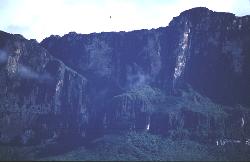 The climb is as spectacular
as it is capricious, clambering up tripping roots, wood and
smoothed stone, round rocks and boulders, across boggy mulch,
between weaves of trunks, until emerging by a small brook
at the base of the cliff. Catching your breath, you look up
through a gap in the canopy. The vertical wall of rock thunders
up into the heavens, shooting down waterdrop arrows which
explode all around. Boddam-Whetham reached this point, but
found the way to the ledge blocked by insurmountable boulders.
Im Thurn wondered if he too would be forced to abandon the
ascent, his doubts exacerbated by the broken-up ledge, and,
more importantly, by the waterfall which vaulted down from
the summit at the far end of the ledge. The climb is as spectacular
as it is capricious, clambering up tripping roots, wood and
smoothed stone, round rocks and boulders, across boggy mulch,
between weaves of trunks, until emerging by a small brook
at the base of the cliff. Catching your breath, you look up
through a gap in the canopy. The vertical wall of rock thunders
up into the heavens, shooting down waterdrop arrows which
explode all around. Boddam-Whetham reached this point, but
found the way to the ledge blocked by insurmountable boulders.
Im Thurn wondered if he too would be forced to abandon the
ascent, his doubts exacerbated by the broken-up ledge, and,
more importantly, by the waterfall which vaulted down from
the summit at the far end of the ledge.
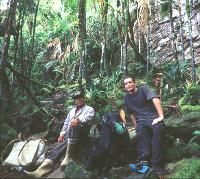 Having
spent the best part of a week cutting a trail through the
matted, soaked undergrowth, on December 18th he finally struck
out with his posse of Pomeroon and Pemon Arekuna porters.
Even now, after so many people have Grand-Old-Duke-of-York'd
up this mountain, it's hard going. But it's difficult to imagine
what unforgiving work slashing this trail for the first time
must have been like. In an expedition to the Guyanese north
face of Roraima in 1971, Adrian Warren's party cut a trail
along the mountain's upper slopes. They progressed only two
miles in six days. An assiduous amateur botanist, Im Thurn
was also collecting plant specimens as he went. Having
spent the best part of a week cutting a trail through the
matted, soaked undergrowth, on December 18th he finally struck
out with his posse of Pomeroon and Pemon Arekuna porters.
Even now, after so many people have Grand-Old-Duke-of-York'd
up this mountain, it's hard going. But it's difficult to imagine
what unforgiving work slashing this trail for the first time
must have been like. In an expedition to the Guyanese north
face of Roraima in 1971, Adrian Warren's party cut a trail
along the mountain's upper slopes. They progressed only two
miles in six days. An assiduous amateur botanist, Im Thurn
was also collecting plant specimens as he went.
As
we climbed higher, sweeps of cloud would reduce visibility
to a few yards. As quickly as they closed in, they disappeared.
When we finally emerged from the forest, the prospect below
resembled a conjured chessboard of forest and plain, sun and
rain - the Enchanter Light pondering his next move. From here,
we made our way down and round a giant boulder, before climbing
again towards the roar in the distance. The waterfall was
in full flow. Donning waterproofs for the first time, we hugged
the edge of the cliff and scurried as best we could over slimy
stone shingles under pounding waves of water.
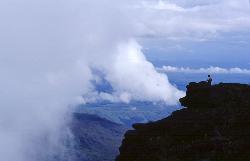 STONE CLOUDS STONE CLOUDS
Beyond
the waterfall, the slope rises more steeply, effectively becoming
a gully between Roraima's dark, menacing ramparts. Picking
our way between hundreds of boulders, islands of numerous
ferns, Befaria heather and Heliamphora struggled, gradually
diminishing in size and number. Soon we'd come level with
the mythical summit of the mountain, enter, as Im Thurn put
it "some strange country of nightmares for which an appropriate
and wildly fantastic landscape had been formed, some dreadful
and stormy day, when, in their mid-career, the broken and
chaotic clouds had been stiffened, in a single instant, into
stone."
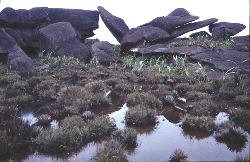 One small step onto a tepuy's
surface is one giant leap onto another planet. It's the Earth,
but not as we know it. Stygian amphitheatres of rock surround
you, carved over millennia by relentless rains and winds.
Faces and profiles, animals and hideous creatures, "apparent
caricatures of umbrellas, tortoises, churches, cannons and
of innumerable other incongruous and unexpected objects"
emerge in their strange, other-worldly shapes. The topography
dances in a funereal carnival of invention. Faint paths of
rubbed-away lighter rock provide the only bearings among the
ghostly, striated rock. Vegetation is sparse, reduced to weird
and wonderful plants, lichens and mosses. Water is everywhere,
running in rivulets, coursing through crags, gathering in
crystal-bottomed pools, faithfully seeking the mountain's
edge from which to hurl itself lemming-like. One small step onto a tepuy's
surface is one giant leap onto another planet. It's the Earth,
but not as we know it. Stygian amphitheatres of rock surround
you, carved over millennia by relentless rains and winds.
Faces and profiles, animals and hideous creatures, "apparent
caricatures of umbrellas, tortoises, churches, cannons and
of innumerable other incongruous and unexpected objects"
emerge in their strange, other-worldly shapes. The topography
dances in a funereal carnival of invention. Faint paths of
rubbed-away lighter rock provide the only bearings among the
ghostly, striated rock. Vegetation is sparse, reduced to weird
and wonderful plants, lichens and mosses. Water is everywhere,
running in rivulets, coursing through crags, gathering in
crystal-bottomed pools, faithfully seeking the mountain's
edge from which to hurl itself lemming-like.
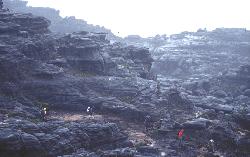 Pagoda labyrinths, valleys
of crystals, dark chasms and inky sinkholes that disappear
in the depths punctuate Roraima's moonscape surface. Star-shaped,
Catherine wheel flowers on long spiny stems, carpets of fluorescent
green moss, spiky yellow-orb flowers and carnivorous pitcher
plants cling to nooks and crannies, sparkling in the rare
moments of blinding sun. Stunted Bonnetia trees with wide
boughs and spindly leaves recall Japanese Zen gardens, the
primeval soup landscape washed over by Hokusai waves of brush-stroke
clouds. Pagoda labyrinths, valleys
of crystals, dark chasms and inky sinkholes that disappear
in the depths punctuate Roraima's moonscape surface. Star-shaped,
Catherine wheel flowers on long spiny stems, carpets of fluorescent
green moss, spiky yellow-orb flowers and carnivorous pitcher
plants cling to nooks and crannies, sparkling in the rare
moments of blinding sun. Stunted Bonnetia trees with wide
boughs and spindly leaves recall Japanese Zen gardens, the
primeval soup landscape washed over by Hokusai waves of brush-stroke
clouds.
The odd bird flits and chatters, but otherwise, the
silence is deafening. Unerring. You lose all sense of scale,
any track of time. The land is old - these were once the valleys
of Gondwana and Pangea, brimming with gold and diamonds, charged
with Life's current for over two billion years. The landscape
is in constant motion. Fluid. Yet completely static - like
a giant cog in the wheel of time, slowly clunking the gears
of evolution, it has witnessed every wonder of Nature, and
every folly of Man.
HYDROLOGY MADE EASY
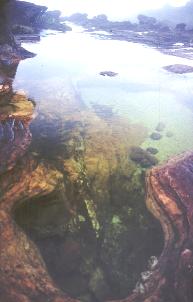 To the north of its surface,
the borders of Venezuela, Guyana and Brazil meet. Roraima
divides their respective watersheds: the Orinoco, Essequibo
and Amazon. Roraima is more than a mountain. In few parts
of the planet are the elements more present. The Guayana Shield's
water cycle, from tepuy to forest to sea and back again, resembles
"Chapter 2: Hydrology" in a 14-year old's Geography
textbook. To the north of its surface,
the borders of Venezuela, Guyana and Brazil meet. Roraima
divides their respective watersheds: the Orinoco, Essequibo
and Amazon. Roraima is more than a mountain. In few parts
of the planet are the elements more present. The Guayana Shield's
water cycle, from tepuy to forest to sea and back again, resembles
"Chapter 2: Hydrology" in a 14-year old's Geography
textbook.
Venezuela's
Canaima National Park, the world's sixth largest park which
protects Roraima, fulfilled all five criteria for inclusion
as a UNESCO World Heritage Site. The waterfalls which spring
from the tepuys - including the world's tallest, Angel Falls
- weave together to form the fishhook arc of the River Caroní,
which in turn disgorges into the mighty Orinoco. Where the
two rivers meet, the Guri Dam furnishes some 70% of the country's
electricity. As much as 40% of the tepuys' species are entirely
endemic, their evolution isolated for millennia. Of the park's
five frogs in the Oreophrynella order, each claims its very
own tepuy.
Although creatures little larger than thumbs are
hardly the stuff of science fiction yarns, regional expert
and guide Roberto Marrero has published a map detailing
UFO phenomena across the national park. The tepuy's profile
make the most Spielbergesque landing site you could possibly
encounter.
I ask Julio about his experiences,
eager for stories of strange beasts. The only animals he's
spotted, in turns out, are the foxes and dogs that come to
scavenge the visitors' food.
PARTING LOOKS
Roraima makes an inhospitable
host. The summit is cold and damp; clothes never dry; you never shake the feeling you shouldn't be present in this
re-animated Dürer engraving at all. The rock's eerie, Wagnerian
forms begin to seep under your skin. After three nights, you're
ready to come down.
As
soon as we began our descent, banks of clouds drew in around
us, and Roraima's drawbridge clanked shut. Nearing the Kukenan
river on our way back, the mountains slowly began to emerge.
We struggled across the river, its hungry waters lapping at
our waists and rucksacks. On the far bank, Julio called me,
nodding his head back towards Roraima. I turned to see the
mountain's walls glowing blood red, serene in the still evening
air. "Parting looks," says the old Welsh proverb,
"are magnifiers of beauty."
A
paragon of modesty, Im Thurn insisted the conquering of Roraima
amounted to no more than "a long walk ending in a successful
scramble" according to R.R. Marrett. I think he was being
bashful. Climbing Roraima, then and now, is a journey to a
unique lost world.

FOR TOURS OF RORAIMA, CONTACT 
For
more on the Gran Sabana and Canaima National Park, see 
|




